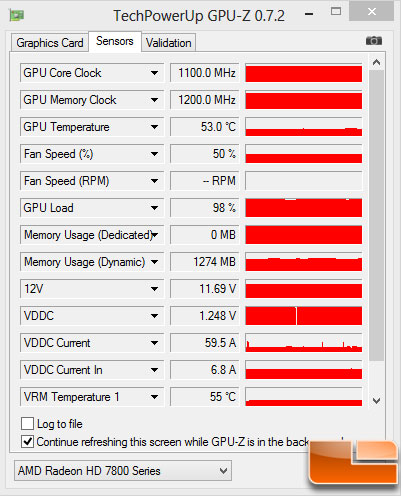Gigabyte Radeon HD 7870 2GB GHz Edition Video Card Review
Temperature and Power Consumption

When sitting in an enclosed case, the temperature of a card can impact the performance. Let’s spend a few minutes looking at how hot the HD7870 got.
| Asus GTX560Ti | Gigabyte HD7870 | |
| Idle: | 43C | 26C |
| Load: | 58C | 52C |
| Difference: | 15C | 26C |
Taking a quick look at the temperature readings, we can see the HD7870 heats up quite a bit. While the GTX560Ti is an older generation, going from idle to load its heat increased by 15C, while the HD7870 increased 26C. However, the HD7870 was still below the GTX560Ti’s maximum temperature of 58C by 6C. Also, let’s not forget to look at the idle temperature, a 17C temperature difference between the two cards is significant.
The temperature of the HD7870 is important because the fan shroud does not force the hot air out of the case, rather it allows it to remain in the case where it needs to escape the system by other means.
Power Consumption
For testing power consumption, a P3 Kill-A-Watt power meter was used. The idle conditions were achieved by allowing the system to sit idle on the desktop for 30 minutes and took the reading. For the load conditions, 3D Mark 2013, Heaven and Crysis was run and the averaged peak results was tracked.
| ASUS GTX 560Ti | Gigabyte HD7870 | |
| Idle | 121W | 80W |
| Load | 227W | 211W |
| Difference | 106W | 131W |
Power Consumption Results: At idle, the Gigabyte HD7870 would idle at 80W and peaked at 211W. That indicates it uses around 131W of power th the MSI N760 HAWK installed the entire system would idle at 99W and peaked at 345W when gaming. The MSI N760 GAMING peaked at 329W in games, which confirms MSI claim that the MSI N760 HAWK has a 15W higher TDP than the MSI N760 GAMING card as we measured a 16 Watt difference at the wall.
